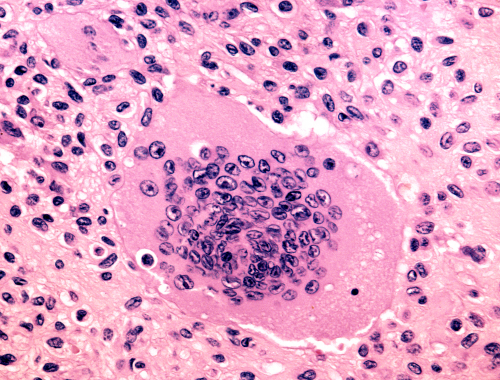Difference Between Polymyalgia Rheumatica and Giant Cell Arteritis
Polymyalgia rheumatica is an inflammatory condition that causes muscle stiffness and pain, especially in the neck, shoulders, hips, and thighs.
Giant cell arteritis, also called temporal arteritis, is the inflammation of large and medium-sized arteries.

What is polymyalgia rheumatica?
Definition:
Polymyalgia rheumatica is an inflammatory condition that causes muscle stiffness and pain, especially in the neck, shoulders, hips, and thighs.
Symptoms:
The main symptoms of polymyalgia rheumatica are muscle pain and stiffness after 50 years of age. The stiffness is so severe that it hampers the ability of a person to climb stairs, reach out for objects, get out of bed, and dress. Symptoms are worse after rest and improve with activity. The patient has chronic fatigue and may have a mild fever. Weight loss is also observed in polymyalgia rheumatica. 40 to 60% of patients have concomitant giant cell arteritis in polymyalgia rheumatica.
Risk factors:
Polymyalgia rheumatica is seen mostly in females after 50 years of age. The disease peaks at 70 years of age.
Diagnosis:
Polymyalgia rheumatica is diagnosed based on symptoms in old-age patients. After history and physical examination, blood tests for inflammation markers such as ESR and CRP are carried out to identify the underlying condition.
Treatment:
Polymyalgia rheumatica has a drastic response to moderate-dose corticosteroids. The disease is controlled by an initial dose of prednisolone which is then tapered off gradually over months.

What is giant cell arteritis?
Definition:
Giant cell arteritis, also called temporal arteritis, is the inflammation of large and medium-sized arteries.
Symptoms:
Symptoms of giant cell arteritis are severe chronic headache, especially in the temporal region, scalp tenderness, jaw pain on eating, fever, fatigue, weight loss, visual disturbances, and loss of vision in one eye.
Risk factors:
Risk factors of giant cell arteritis include age greater than 50, female gender, Northern European descent, polymyalgia rheumatica, and positive family history.
Diagnosis:
History and physical examination will show the typical signs and symptoms of giant cell arteritis. The temporal arteries are hard, tender and have a diminished pulse. Blood tests such as ESR and CRP are raised. The definite diagnostic investigation for giant cell arteritis is temporal artery biopsy.
Treatment:
High doses of steroids and low-dose aspirin are given for giant cell arteritis.
Difference between Polymyalgia rheumatica and Giant cell arteritis
Definition:
Polymyalgia rheumatica is an inflammatory condition that causes muscle stiffness and pain, especially in the neck, shoulders, hips, and thighs. Giant cell arteritis, also called temporal arteritis, is the inflammation of large and medium-sized arteries.
Symptoms:
The main symptoms of polymyalgia rheumatica are muscle pain and stiffness after 50 years of age. The stiffness is so severe that it hampers the ability of a person to climb stairs, reach out for objects, get out of bed, and dress up. Symptoms are worse after rest and improve with activity. The patient has chronic fatigue and may have a mild fever. Weight loss is also observed in polymyalgia rheumatica. 40 to 60% of patients have concomitant giant cell arteritis in polymyalgia rheumatica. Symptoms of giant cell arteritis are severe chronic headache, especially in the temporal region, scalp tenderness, jaw pain on eating, fever, fatigue, weight loss, visual disturbances, and loss of vision in one eye.
Risk factors:
Polymyalgia rheumatica is seen mostly in females after 50 years of age. The disease peaks at 70 years of age. Risk factors of giant cell arteritis include age greater than 50, female gender, Northern European descent, polymyalgia rheumatica, and positive family history.
Diagnosis:
Polymyalgia rheumatica is diagnosed based on symptoms in old-age patients. After history and physical examination, blood tests for inflammation markers such as ESR and CRP are carried out to identify the underlying condition.
History and physical examination will show the typical signs and symptoms of giant cell arteritis. The temporal arteries are hard, tender and have a diminished pulse. Blood tests such as ESR and CRP are raised. The definite diagnostic investigation for giant cell arteritis is temporal artery biopsy.
Treatment:
Polymyalgia rheumatica has a drastic response to moderate-dose corticosteroids. The disease is controlled by an initial dose of prednisolone which is then tapered off gradually over months.
High doses of steroids and low-dose aspirin are given for giant cell arteritis.
Table of differences between Polymyalgia rheumatica and Giant cell arteritis

FAQs
What is the difference between Polymyalgia rheumatica and Giant cell arteritis?
Polymyalgia rheumatica is an inflammatory condition that causes muscle stiffness and pain, especially in the neck, shoulders, hips, and thighs.
Giant cell arteritis, also called temporal arteritis, is the inflammation of large and medium-sized arteries.
Can Polymyalgia rheumatica and Giant cell arteritis occur together?
Yes.
Are there any long-term complications associated with Polymyalgia rheumatica or Giant cell arteritis?
Yes, both these conditions have long-term complications. Polymyalgia rheumatica can cause muscle weakness, depression, osteoporosis, and weight loss whereas giant cell arteritis can cause complete vision loss, stroke, and aneurysm.
Can lifestyle changes help manage symptoms of Polymyalgia rheumatica or Giant cell arteritis?
Yes, a healthy diet and exercise can help relieve muscle stiffness in polymyalgia rheumatica and reduce the risk of cardiovascular disease in giant cell arteritis.
Can Polymyalgia rheumatica or Giant cell arteritis lead to other health problems?
Yes.
How often should someone with Polymyalgia rheumatica or Giant cell arteritis have follow-up appointments with their doctor?
Every week if the symptoms are not controlled and for 3 to 6 months if symptoms are under control.
Who is most at risk for developing Polymyalgia rheumatica or Giant cell arteritis?
Females greater than 50 years old, with a positive family history.
Can Polymyalgia rheumatica or Giant cell arteritis affect younger people?
Very rarely.
How do Polymyalgia rheumatica and Giant cell arteritis impact daily life?
Yes, they have an adverse effect on the quality of life.
What medications are used to treat Polymyalgia rheumatica and Giant cell arteritis?
Steroids and aspirin.
Can Polymyalgia rheumatica or Giant cell arteritis impact vision?
Giant cell arteritis can cause sudden loss of vision.
What tests are typically performed to diagnose Polymyalgia rheumatica or Giant cell arteritis?
ESR and CRP for polymyalgia rheumatica and temporal biopsy for giant cell arteritis.
Are there any alternative therapies that can help manage symptoms of Polymyalgia rheumatica or Giant cell arteritis?
Alternative therapies such as acupuncture, yoga, dietary supplements, and massage therapy have minimal benefits for these two conditions.
Can changes in climate or weather impact symptoms of Polymyalgia rheumatica or Giant cell arteritis?
Yes, to some extent. A cold climate worsens muscle pain and stiffness whereas a warm climate relieves the symptoms.
Can stress or anxiety trigger symptoms of Polymyalgia rheumatica or Giant cell arteritis?
Yes, however the evidence is scarce.
How does the outlook for someone with Polymyalgia rheumatica or Giant cell arteritis differ from someone without these conditions?
These conditions affect the quality of life and can lead to long-term disability. These can cause stress and mental health issues.
- Differences Between Reptiles and Amphibians - May 17, 2024
- Difference Between Ophthalmology and Optometry - May 15, 2024
- Difference Between Fear and Anxiety - April 2, 2024
Search DifferenceBetween.net :
Leave a Response
References :
[0]González-Gay, Miguel A., Eric L. Matteson, and Santos Castañeda. "Polymyalgia rheumatica." The Lancet 390.10103 (2017): 1700-1712.
[1]Michet, Clement J., and Eric L. Matteson. "Polymyalgia rheumatica." Bmj 336.7647 (2008): 765-769.
[2]Salvarani, Carlo, et al. "Polymyalgia rheumatica and giant-cell arteritis." New England Journal of Medicine 347.4 (2002): 261-271.
